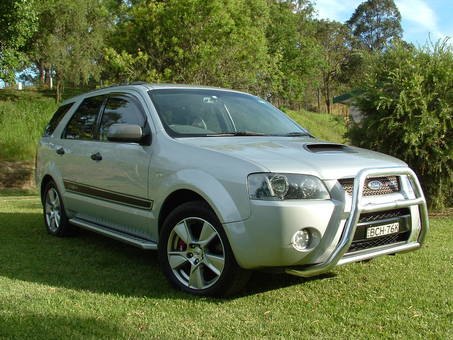TTAC Salutes The Ford Territory
While the Ford Falcon is getting the bulk of the attention with respect to Ford’s soon-to-be-shuttered Australian operations, Ford also made another product, based off the Falcon platform, that never made it to our shores. The Ford Territory might be the most desirable CUV ever made.
The FPV F6X (pictured above) borrowed the Falcon FPV6’s 362 horsepower turbocharged I6 but retained the Territory’s AWD system. 60 mph came up in about 6 seconds, but the FPV F6X had a big problem; a Falcon XR6T with a more powerful I6 engine was about 30 percent cheaper, and the F6X was barely distinguishable from the regular Territory Turbo. Sales were predictably slow and the F6X lasted one year only.
Although there were calls to export the Territory, nothing ever really got off the ground, and the Territory was left to its home market of Australia, as well as a handful of exports to right-hand drive countries like Thailand. At one time, there were even calls to send it to the United States, but it’s difficult to imagine American consumers caring enough about the rear-drive layout and I6 engine when it looked nearly identical to the Freestyle/Taurus X and carrying the price premium associated with being an Australian import.
I can’t help but feel saddened knowing that the Territory is marked for death along with the Falcon. The business case may no longer be there, but the Territory represents an increasingly rare-breed in the automotive world; a vehicle that was derived as a unique solution to local tastes and attitudes. The fact that it could give many sports cars a real fight in a drag race, while looking like an ordinary family hauler makes it even more bittersweet.
More by Derek Kreindler
Latest Car Reviews
Read moreLatest Product Reviews
Read moreRecent Comments
- Theflyersfan The wheel and tire combo is tragic and the "M Stripe" has to go, but overall, this one is a keeper. Provided the mileage isn't 300,000 and the service records don't read like a horror novel, this could be one of the last (almost) unmodified E34s out there that isn't rotting in a barn. I can see this ad being taken down quickly due to someone taking the chance. Recently had some good finds here. Which means Monday, we'll see a 1999 Honda Civic with falling off body mods from Pep Boys, a rusted fart can, Honda Rot with bad paint, 400,000 miles, and a biohazard interior, all for the unrealistic price of $10,000.
- Theflyersfan Expect a press report about an expansion of VW's Mexican plant any day now. I'm all for worker's rights to get the best (and fair) wages and benefits possible, but didn't VW, and for that matter many of the Asian and European carmaker plants in the south, already have as good of, if not better wages already? This can drive a wedge in those plants and this might be a case of be careful what you wish for.
- Jkross22 When I think about products that I buy that are of the highest quality or are of great value, I have no idea if they are made as a whole or in parts by unionized employees. As a customer, that's really all I care about. When I think about services I receive from unionized and non-unionized employees, it varies from C- to F levels of service. Will unionizing make the cars better or worse?
- Namesakeone I think it's the age old conundrum: Every company (or industry) wants every other one to pay its workers well; well-paid workers make great customers. But nobody wants to pay their own workers well; that would eat into profits. So instead of what Henry Ford (the first) did over a century ago, we will have a lot of companies copying Nike in the 1980s: third-world employees (with a few highly-paid celebrity athlete endorsers) selling overpriced products to upper-middle-class Americans (with a few urban street youths willing to literally kill for that product), until there are no more upper-middle-class Americans left.
- ToolGuy I was challenged by Tim's incisive opinion, but thankfully Jeff's multiple vanilla truisms have set me straight. Or something. 😉


































Comments
Join the conversation
I must say--TTAC is an almost irelevant car site.
My first thought on seeing that pic. Wrap that bumper in a pink material and the car would look like a dog with its tongue trying to lick its nose.